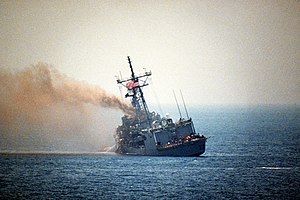This is an old revision of this page, as edited by 69.224.222.104 (talk) at 06:31, 24 April 2006. The present address (URL) is a permanent link to this revision, which may differ significantly from the current revision.
Revision as of 06:31, 24 April 2006 by 69.224.222.104 (talk)(diff) ← Previous revision | Latest revision (diff) | Newer revision → (diff)
| |
| Career | |
|---|---|
| Laid down: | 24 August 1979 |
| Launched: | 30 May 1980 |
| Commissioned: | 23 October 1982 |
| Decommissioned: | 7 May 1999 |
| Fate: | Berthed at Naval Inactive Ship Maintenance Facility, Philadelphia, PA |
| Struck: | 17 May 1987 |
| General Characteristics | |
| Displacement: | 3638 tons |
| Length: | 445 ft (136 m) |
| Beam: | 45 ft (13.7 m) |
| Draught: | 14 ft 9 in (4.5 m) |
| Propulsion: | 2 × General Electric LM2500 gas turbines; 41,000 shp (30,600 kW); 1 shaft, cp propeller, 325 hp (242 kW) retractable propeller pods |
| Speed: | 29 knots (54 km/h) |
| Range: | |
| Complement: | 206 |
| Armament: | 1 OTO Melara 76mm/62 (single) Mk 75, 1 Vulcan Phalanx CWIS, 4 x .50 cal (12.7 mm) MGs, 4 McDonnell Douglas Harpoon missiles36 GDC Pomona Standard SM-1MR missiles, 1 Mk 13 Mod 4 launcher for both, 6 x 324mm US Mk 32 (2 triple) tubes for 46 torpedoes |
USS Stark (FFG-31), twenty-third ship of the Oliver Hazard Perry class of guided-missile frigates, was named for Admiral Harold Rainsford Stark (1880–1972).
Ordered from Todd Shipyards, San Pedro, California on 23 January 1978 as part of the FY78 program, Stark was laid down on 24 August 1979, launched on 30 May 1980, and commissioned on 23 October 1982. Decommissioned on 7 May 1999 and stricken the same day, Stark is currently awaiting disposal at Naval Inactive Ships Maintenance Facility in Philadelphia, PA.
Stark (FFG-31) was the first ship of that name in the US Navy.
Stark was deployed to the Middle East Force in 1984 and 1987. The ship was struck on May 17, 1987, by two Exocet antiship missiles fired from an Iraqi Mirage fighter during the Iran-Iraq War. The fighter had taken off from Shaibah at 20:00 and had flown south into the Persian Gulf. Shortly after being routinely challenged by the frigate around 22:10, the fighter fired two Exocet missiles. The frigate did not detect the missiles, and both struck without warning. The first hit the port-side hull, penetrated it, yet failed to detonate. The second entered at almost the same point, and left a 3-by-4-meter gash—then exploded in crew quarters. Thirty-seven crew were killed and twenty-one were injured.
Afire and listing, the frigate was brought under control by its crew during the night. The ship returned to Bahrain, then to its homeport of Mayport, Florida, under her own power. Repairs cost $142 million.
This has been called the U.S. Navy's deadliest peacetime disaster before the gun turret explosion onboard Iowa.
According to Iraqi officials, the pilot who attacked the Stark was not punished. Though American officials believed he had been executed, journalist Robert Fisk, in his book The Great War For Civilisation, quotes an ex-Iraqi Air Force commander who says the pilot is still alive.
Stark was part of the Standing Naval Forces Atlantic Fleet in 1990 before returning to the Middle East Force in 1991. She was attached to UNITAS in 1993 and took part in Operation Support Democracy and Operation Able Vigil in 1994. In 1995 she again returned to the Middle East Force before serving in the Atlantic again in 1997 and in 1998.
Further reading
- Levinson, Jeffrey L. and Randy L. Edwards (1997). Missile Inbound. Annapolis: Naval Institute Press. ISBN 1557505179.